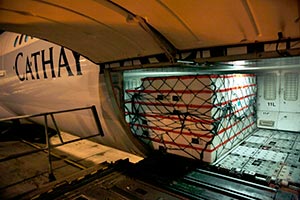Gridlock at West Coast Ports Boosts Airfreight

The U.S. military ordered yogurt and cottage cheese flown to forces in Japan and South Korea last month as a labor dispute began jamming up West Coast ports.
Honda Motor Co. and Fuji Heavy Industries resorted to airlifting parts to U.S. plants to bypass the clogged container terminals. Planes carried potatoes in the other direction so McDonald’s Corp. could end rationing of french fries in Japan.
The shift of seaborne cargo to jets’ bellies shows how Asian airlines including ANA Holdings Inc. and Cathay Pacific Airways are benefiting from gridlock at ports in California and Washington state. Loading and unloading of vessels at ports from San Diego to Bellingham, Washington, were suspended from Feb. 7 through the morning of Feb. 9, according to the Pacific Maritime Association.
“We can’t stop our factory in the U.S.,” Masayuki Takeuchi, a spokesman for Tokyo-based manufacturer Hitachi Ltd., said by phone. “West Coast ports are very important gateways for us to move our goods to factories in the U.S. Costs will increase to send by air, but we recognize that it’s necessary.”
Air shipments can be 15 to 20 times as expensive as sea travel, according to Satish Jindel, founder of Sewickley, Pennsylvania-based shipping consultant SJ Consulting Group Inc. A typical strategy for manufacturers is to send some of their parts needs by plane to smooth out any disruptions by ocean, Jindel said.
“Since autumn last year, ANA cargo flights to the U.S. from Japan have been full, there is no space,” said Motoki Nishinaka, a spokesman at the carrier. “Delays are getting worse and worse, while auto demand in the U.S. is getting higher and higher.”
Fuji Heavy’s Subaru is among the carmakers facing the prospect of higher bills to ensure components get through. The switch to airfreight from ocean vessels may increase costs by 7 billion yen ($59.6 million) per month, according to Mitsuru Takahashi, the automaker’s chief financial officer.
Cargo is important to carriers in Asia, home to about half of the 10 biggest airlines for airfreight, and is a bigger business than for their U.S. peers. In 2013, freight accounted for about 24% of Cathay Pacific’s sales, compared with about 2.5% at United Continental Holdings Inc., the U.S. airline with the most cargo revenue, according to data compiled by Bloomberg.
“The airlines could see the benefits of this for up to three months,” said Neel Jones-Shah, a former Delta Air Lines Inc. cargo executive who is now an aviation consultant and freight forwarder in Los Angeles. “A port strike doesn’t turn a bad year into a good year. It could turn a bad month into a good month, maybe a great month.”
Productivity at many ports is down as much as half amid stalled contract talks with the International Longshore and Warehouse Union, suggesting that freight movement “will collapse under its own weight,” according to James McKenna, the president of the Pacific Maritime Association, which represents terminal operators.
McKenna predicted Feb. 3 that union-led slowdowns would force the closing of the 29 U.S. West Coast ports in five to 10 days as goods pile up. The union said management was responsible for the congestion crisis.
As of Thursday, 24 inbound ships queued up at anchor outside the harbor shared by the Los Angeles and Long Beach ports, according to the Marine Exchange of Southern California. That’s up from as few as four in mid-December.
The ship-to-plane shift across the Pacific is adding momentum to a rebound in global air cargo. Volumes rose 4.5% in 2014 as measured by freight-ton kilometers, more than triple the 1.4% gain for 2013, according to the International Air Transport Association.
“Across the board, products are being shifted from ocean to air as supply chains have been disrupted,” Hong Kong-based Cathay Pacific said by e-mail.
Companies that can’t afford to wait on a cargo diversion -- or risk a delay -- will pay what’s necessary to keep parts flowing to assembly lines, said Jones-Shah, who is president of JS Aviation Consulting and chief commercial officer for Able Freight.
“When you get these extraordinary circumstances, costs get thrown out the window to a certain extent,” Jones-Shah said in a telephone interview. “Shutting down a factory or production line is significantly more expensive, particularly right now because there’s pretty robust demand.”
The Defense Commissary Agency, which manages military grocery stores on U.S. military facilities in South Korea, Japan and other locations, said in an e-mailed response to Bloomberg that the West Coast port slowdowns have caused transportation delays of as long as 15-20 days.
Negotiations on a new labor agreement for the Longshore union have been under way since May. Since early November, the union has been dispatching fewer crane operators in Los Angeles and Long Beach and slowing cargo movement in Oakland, California; Seattle and nearby Tacoma, Washington, according to a Feb. 3 maritime association presentation.
A 20-day lockout now would cost more than $2 billion a day, the association said in a 2014 report, including losses to railroads, ocean carriers and the broader economy. For airlines, the prospect is brighter, according to Cathay Pacific.
“Given that there does not seem to be a quick or easy solution to the issues causing port congestion, reduced gas prices in the U.S. have put more money in consumers’ pockets and that overall the US economy is stronger, trans-Pacific air freight will remain strong throughout 2015,” Cathay Pacific said.
Airfreight tonnage rose 21% in San Francisco in December, and 16% in Seattle, among the largest gains at major U.S. airports, according to data compiled by Bloomberg. Volumes at Los Angeles’ two large airports climbed 10%.
Airlines “may have opportunities to get better rates for that service and see more of that capacity being utilized instead of going empty,” said Jindel, the Pennsylvania-based consultant. “It should be a good boost to revenue and to margins if they manage the business well.

